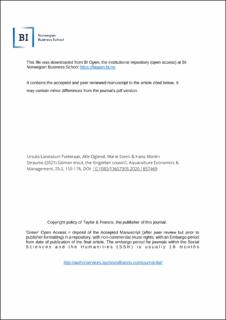| dc.contributor.author | Landazuri-Tveteraas, Ursula | |
| dc.contributor.author | Oglend, Atle | |
| dc.contributor.author | Steen, Marie | |
| dc.contributor.author | Straume, Hans-Martin | |
| dc.date.accessioned | 2022-02-14T11:26:41Z | |
| dc.date.available | 2022-02-14T11:26:41Z | |
| dc.date.created | 2020-12-16T09:39:51Z | |
| dc.date.issued | 2020 | |
| dc.identifier.citation | Aquaculture Economics & Management, 2021, 25:2, 159-176, | en_US |
| dc.identifier.issn | 1365-7305 | |
| dc.identifier.uri | https://hdl.handle.net/11250/2978728 | |
| dc.description.abstract | This study investigates potential economic reasons why the production of trout is maintained in Norway by analyzing prices and production for Norwegian Atlantic salmon and trout. The species Atlantic salmon dominates the global salmon market, but its two largest producers, Norway and Chile also farm in sea pens significant quantities of large rainbow trout (as opposed to portion-sized Rainbow trout farmed in freshwaters in other parts of the World, e.g., Iran, Peru, Turkey, and others). Suggesting that these trout have some attributes that make it a useful complement to Atlantic salmon. We investigate development in supply volumes of these species and conduct a cointegration analysis using monthly prices from 2000 to 2018. The results show that the markets for fresh and frozen rainbow trout are tightly integrated with fresh Atlantic salmon, and, where the latter is a price leader. This means that many consumers consider the two products as substitutes, with no clear preferences. There is no apparent productivity argument for the continued production of rainbow trout vis-à-vis Atlantic salmon. However, there may exist a fringe of consumers that prefer its characteristics, motivating firms to maintain its production as a means of diversification. | en_US |
| dc.language.iso | eng | en_US |
| dc.publisher | Taylor and Francis | en_US |
| dc.rights | Attribution-NonCommercial-NoDerivatives 4.0 Internasjonal | * |
| dc.rights.uri | http://creativecommons.org/licenses/by-nc-nd/4.0/deed.no | * |
| dc.title | Salmon trout, the forgotten cousin? | en_US |
| dc.type | Journal article | en_US |
| dc.type | Peer reviewed | en_US |
| dc.description.version | acceptedVersion | en_US |
| dc.source.pagenumber | 157-176 | en_US |
| dc.source.volume | 25 | en_US |
| dc.source.journal | Aquaculture Economics & Management | en_US |
| dc.source.issue | 2 | en_US |
| dc.identifier.doi | https://doi.org/10.1080/13657305.2020.1857469 | |
| dc.identifier.cristin | 1860349 | |
| cristin.ispublished | true | |
| cristin.fulltext | postprint | |
| cristin.qualitycode | 1 | |

